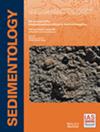Co-precipitation of primary dolomite and Mg-rich clays in Deep Springs Lake, California
IF 2.8
2区 地球科学
Q1 GEOLOGY
引用次数: 0
Abstract
In contrast to the prevalence of dolomite [CaMg(CO3)2] in the geological record, there are few instances of recent formation. This discrepancy occurs despite supersaturation with respect to dolomite in many modern marine and lacustrine environments. Additionally, laboratory experiments have struggled to precipitate dolomite at ambient temperatures (<40°C) even under highly saturated conditions. However, recent work has found dissolved silica to be an effective catalyst for the direct precipitation of dolomite. To test this hypothesis, the hydrology and mineralogy of Deep Springs Lake, a playa setting with primary dolomite precipitation has been explored. In this study, the central playa sites with the highest sedimentation rates were found to have dissolved silica concentrations close to saturation. Rietveld refinement showed that bulk mineral assemblages of core samples contain 20 to 40% fine-grained, partially ordered dolomite along with a 10 to 20% poorly crystalline clay fraction, while transmission electron microscopy imaging found a co-precipitation relationship between the fine-grained dolomite and Mg-rich smectite clays, where the Mg-rich smectite clays act as a sink for the excess dissolved silica during evaporation. Transmission electron microscopy results indicate that the nanodolomite crystals formed through surface-induced nucleation and growth processes in the presence of dissolved silica as a catalyst. The broad coincidence of conditions for the direct precipitation of dolomite and Mg-rich smectite clays provides evidence that silica may be a key to the dolomite problem, as well as constraining palaeoenvironments such as the Pre-salt Barra Velha Formation.加利福尼亚州深泉湖中原生白云石和富镁粘土的共沉淀
与地质记录中白云石[CaMg(CO3)2]的普遍存在相反,近期形成的白云石却很少。尽管在许多现代海洋和湖泊环境中白云石都处于过饱和状态,但还是出现了这种差异。此外,即使在高度饱和的条件下,实验室实验也很难在环境温度(40°C)下析出白云石。然而,最近的研究发现,溶解的二氧化硅是直接沉淀白云石的有效催化剂。为了验证这一假设,我们对深泉湖的水文和矿物学进行了研究,这是一个有原生白云石沉淀的洼地环境。在这项研究中,发现沉积速率最高的中部洼地的溶解二氧化硅浓度接近饱和。里特维尔德精炼法显示,岩芯样本的大块矿物组合中含有 20% 至 40% 的细粒、部分有序的白云石,以及 10% 至 20% 的结晶度较差的粘土部分,而透射电子显微镜成像发现,细粒白云石与富含镁的直闪石粘土之间存在共沉淀关系,其中富含镁的直闪石粘土在蒸发过程中充当了过量溶解二氧化硅的沉淀池。透射电子显微镜结果表明,纳米白云石晶体是在有溶解二氧化硅作为催化剂的情况下,通过表面诱导成核和生长过程形成的。白云石和富镁硅质粘土直接沉淀条件的广泛吻合提供了证据,证明二氧化硅可能是白云石问题的关键所在,同时也限制了前盐湖巴拉韦利亚地层等古环境的形成。
本文章由计算机程序翻译,如有差异,请以英文原文为准。
求助全文
约1分钟内获得全文
求助全文
来源期刊

Sedimentology
地学-地质学
CiteScore
8.20
自引率
11.40%
发文量
94
审稿时长
6-12 weeks
期刊介绍:
The international leader in its field, Sedimentology publishes ground-breaking research from across the spectrum of sedimentology, sedimentary geology and sedimentary geochemistry.
Areas covered include: experimental and theoretical grain transport; sediment fluxes; modern and ancient sedimentary environments; sequence stratigraphy sediment-organism interaction; palaeosoils; diagenesis; stable isotope geochemistry; environmental sedimentology
 求助内容:
求助内容: 应助结果提醒方式:
应助结果提醒方式:


